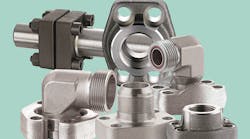This file type includes high resolution graphics and schematics when applicable.
Although they come in different configurations, many SAE 4-bolt hydraulic flanges look quite similar to each other. Nonetheless, SAE Code 61, SAE Code 62, and Caterpillar 4-bolt flanges, in particular, exhibit small dimensional and physical differences that cannot be ignored.
A Case in Point
The consequences of improperly identifying a particular flange type were described by Rory McLaren, Director of the Fluid Power Safety Institute (FPSI), West Valley City, Utah. He explained that a diesel mechanic with no formal training in hydraulics installed a new hydraulic motor on a machine. When he reconnected the hydraulic hoses to the motor, he found that the bolt holes on the 4-bolt, split flanges did not line up with the holes in the motor housing.
Thinking the holes had simply not been drilled in the correct position on the motor, the mechanic began filing the holes so that they would accommodate the bolts from the split flange. In no time at all, he had "corrected" the problem.
With nothing more than on-the-job training, the mechanic did not realize that he was modifying an SAE Code 62 (6,000 psi) 4-bolt flange to fit an SAE Code 61 (3,000 psi) motor. The new motor he installed on the machine was incorrect for the application.
The mechanic unknowingly removed the only indication protecting him from making the error of installing a 3,000-psi component into a 6,000-psi system—the the bolt-hole dimensions.
Dimensional Differences
In addition to the bolt-hole’s center-to-center dimensions, other physical differences exist between the SAE Code 61 and the SAE Code 62 4-bolt flanges. Using a 1-in. flange as an example, the accompanying illustration superimposes a Code 61 flange over a Code 62 flange, revealing how dimensionally similar they are to each other.
The distance between hole centers for a 1-in. Code 61 and Code 62 flange differs by a meager 0.064 in. for dimension A and only 0.188 in. for dimension B. But that’s only part of the problem.
Caterpillar apparently makes a nearly identical version of the SAE Code 62 4-bolt flange. However, the Cat version differs from the standard SAE Code 62 flange head in one aspect. The SAE Code 62 thickness (dimension C in the illustration) ranges from 0.305 in. on the ½-in. flange to 0.495 in. on the 2-in. flange, but Caterpillar makes has a flange head dimension of 0.560 in. for all 4-bolt flanges.
Accordingly, if you are working in a situation where you have SAE Code 61, SAE Code 62, and Caterpillar 4-bolt flanges, you must be careful not to make errors in determining what fits where. The potentially catastrophic consequences of incorrect flange identification mandate training in fluid-power connectors.
Avoid 4-Bolt Flange Confusion
To help avoid mistaking 4-bolt flanges for one another, the FPSI prepared the accompanying table, which summarizes dimensions of the different common types and sizes of 4-bolt flanges. Keep in mind that the bolt-hole dimensions of captive (one-piece) and split (two-piece) flanges for a given size are identical.
However, even with proper training, it still requires time and close attention to distinguish one type of flange from another. As an aid to quickly make those differentiations, Hydra-Check Inc. of West Valley City, Utah, developed a 4-bolt flange identification template.
OPTIONAL: Flange ID.jpg
The template consists of clearly marked slots for SAE Code 61, SAE Code 62, and Caterpillar 4-bolt flanges. Positive identification is made by simply matching the particular connector with the corresponding identification slot. Visit www.hydracheck.com for more information on the template and other products offered by Hydra-Check.
This information was provided by Rory McLaren, Director of the Fluid Power Safety Institute. For more information on hydraulic safety products, videos, blogs, email newsletters, and other resources, visit www.fluidpowersafety.com.






